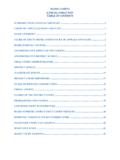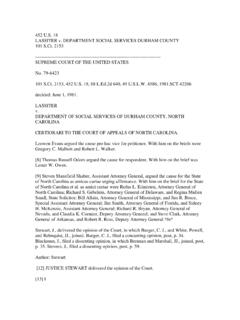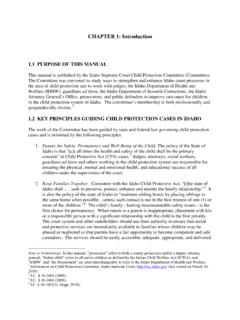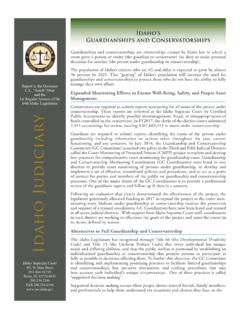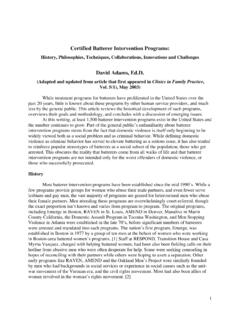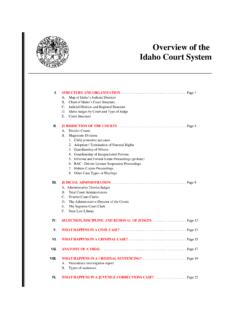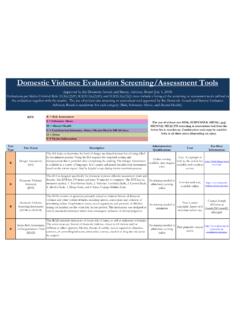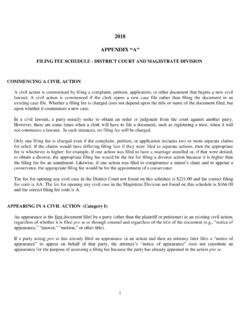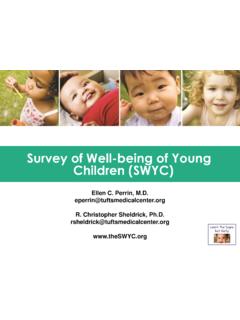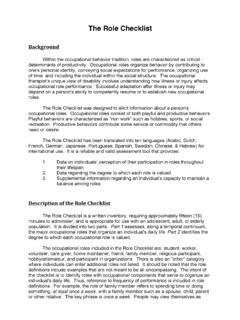Transcription of Safety • Stability • Well Being Checklist to Promote ...
1 INTRODUCTIONJ udges need information and tools to both guide them in holding perpetrators of domestic violence accountable for their abusive behavior and to ensure that efforts to reach perpetrators1 do not cause unintended consequences or further harm to victims of domestic violence and their children. This Checklist to Promote Perpetrator Accountability in Dependency Cases Involving Domestic Violence (Accountability Checklist ) will help dependency judges intervene with those who use violence in ways that Promote accountability and maximize the Safety and well - Being of children and victim parents.
2 It provides a framework to help the court leverage its authority to hold perpetrators accountable, provide appropriate services, and improve judicial decision-making. This Accountability Checklist complements the Reasonable Efforts Checklist for Dependency Cases Involving Domestic Violence2 (Reasonable Efforts Checklist ) by providing specialized information to hold perpetrators of domestic violence accountable in child protection cases. Much of the narrative accompanying the Reasonable Efforts Checklist is also applicable to this Accountability Accountability Checklist will help judges:Gather information needed to enhance decision-making on accountability issues;Assess the risk posed by perpetrators to lessen perpetrator-generated Safety threats to children and victim parents;Review and tailor service plans to hold perpetrators accountable in ways that Promote Safety and compliance with orders.
3 Evaluate treatment options to enhance perpetrators capacity to change; Strengthen judicial decision-making about placement and visitation of children to increase the Safety of children and victim parents; and1 Statistically, the mother is at far greater risk of Being abused by the child s father than he is by her. See Bu r e a u Ju s t. st a t., De p t Ju s t., Fa m i l y Vi o l e n c e st a t i s t i c s o n st r a n g e r s a nD ac q u a i n t a n c e s 1 (2005), available at (finding that females were 84 percent of spouse abuse victims, 86 percent of victims of abuse by a boyfriend or girlfriend, and 58 percent of family murder victims).
4 For the purposes of this publication, victims of domestic violence will be referred to as female, perpetrators as male. 2 Available online at Craft judicial policies and practices that Promote the accountability of perpetrators and the Safety of victim parents and children. DEFINITIONS OF DOMESTIC VIOLENCEFor purposes of this tool, we define domestic violence as a pattern of assaultive and coercive behaviors that operate at a variety of levels physical, psychological, emotional, financial, or sexual that one parent uses against the other parent.
5 The pattern of behaviors is neither impulsive nor out of control, but is purposeful and instrumental in order to gain compliance or control. It can include assault, destruction of property, isolation, and acts or threats of abuse against the victim parent, children, and pets. Abuse is likely to increase at the time of separation. Perpetrators often use court proceedings or threats of court proceedings and non-compliance with court orders to continue control over the victim parent and children. If courts focus exclusively on the legal definitions of domestic violence (usually assault and violation of protection orders) the underlying pattern of abusive behavior may not be apparent.
6 Understanding the underlying pattern of fear, control, intimidation, and psychological abuse is essential to understanding the impact of domestic violence on victim parents and children. These same patterns of coercive control are often evident in the perpetrator s behaviors with child protection and supervised visitation Stability well BeingChecklist to Promote Perpetrator Accountability in Dependency Cases Involving Domestic ViolenceMajor sources used to compile the information contained in this Accountability Checklist include: Lundy Bancroft, National Council of Juvenile and Family Court Judges, The Batterer as Parent, 6 sy n e r g y (Winter 2002).
7 Lundy Bancroft & Jay Silverman, as s e s s i n g ri s k t o ch i lD r e n Fr o m Ba t t e r e r s (2002); Leigh Goodmark, Achieving Batterer Accountability in the Child Protection System, 93 ky. 613 (2004); Leigh Goodmark, National Council of Juvenile and Family Court Judges, re a s o n aB l e eF Fo r t s ch e c k l i s t F o r De p e nD e n c y ca s e s in V o lV i n g Do m e s t i c Vi o l e n c e (2009); Margaret Hobart, Washington State Coalition Against Domestic Violence, Ba t t e r e r ac c o u n t aB i l i t y: re s p o nD i n g t o ch i lD ma l t r e a t m e n t a nD Do m e s t i c Vi o l e n c e (2008).
8 Peter Jaffe, Claire Crooks & Francis Wong, Parenting Arrangements After Domestic Violence, 6 J. ct r. Fa m. ch i lD r e n & ct s. (2005); Fernando Mederos, Family Violence Prevention Fund, ac c o u n t aB i l i t y a nD co n n e c t i o n w i t h aB u s iV e me n (2004). providers should be aware of the indicators of the agency screen the family for domestic violence when the case was first opened and at other appropriate intervals?Is the perpetrator dangerous? 5 Does he blame someone other than himself 9for his violence?
9 Does he minimize his violence? 9 Does he use or threaten to use a weapon? 9 Does he own a firearm? 9 Does he use drugs or alcohol? 9 Does he ever threaten or try to commit 9suicide?Does he threaten to harm the victim s 9children?Does he engage in stalking behavior? 9 Has he ever strangled the victim? 9Is he excessively jealous of his victims? 9 Did the agency assess the perpetrator for strengths? This may include:Identifying relatives or individuals in 9the perpetrator s life who can provide meaningful support and accountability to change the perpetrator s behaviors and how to engage the perpetrator s 9family and community to support his use of as to factors that may motivate the 9perpetrator to the ways the perpetrator cares 9for the with the victim parent so the 9agency may determine what might motivate the perpetrator to change behaviors and what might hold him of the accountability process for
10 Perpetrators includes establishing responsible parenting consistent with Safety for the victim parent and the agency assessed the perpetrator for fatherhood capacity?What is his attachment to the children? 9 How does he believe the children are affected 9by his violence?What fears does he have about the children s 9future?How do the children figure into his decision- 9making?Has the agency allocated resources to the 9perpetrator to help him become a better parent?5 Jacquelyn C. Campbell, Da n g e r as s e s s m e n t, Johns Hopkins University, School of Nursing, available at INFORMATION Did the child protection agency (agency) gather information about the perpetrator and his violence from the following sources?
